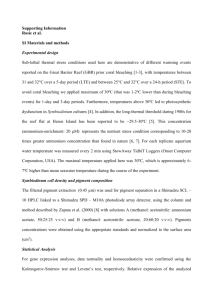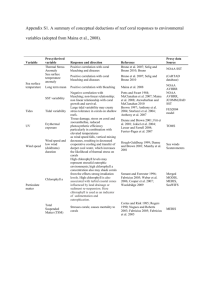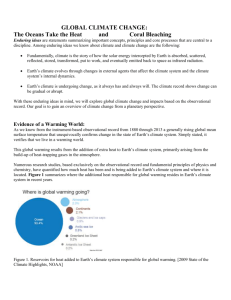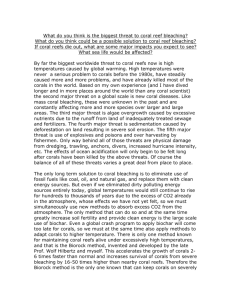24-25
advertisement
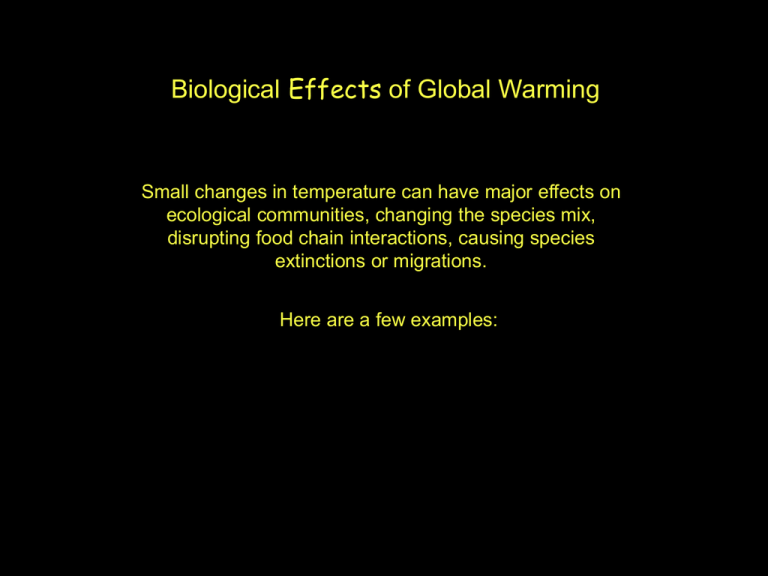
Biological Effects of Global Warming Small changes in temperature can have major effects on ecological communities, changing the species mix, disrupting food chain interactions, causing species extinctions or migrations. Here are a few examples: In the arctic, plants have been moving steadily northward as the climate warms. ice polar desert tundra boreal forest temperate forest shrub expansion tree expansion no change ?? uncertain ? The fatty, oily Arctic cod is ideal prey for seals, narwhals and salmon in the Arctic, but global warming could be shaking up the entire food web and starving the cod itself because of shrinking and shifting pack ice. Sea ice, marine plants, plankton and Arctic cod form an inter-related food web that sustains other animals such as polar bears and ivory gulls. Now, however, the delicate process by which the marine plants grow from the sea ice is threatened by global warming. "Global warming is pulling the rug out from beneath the Arctic's food supply because the survival of many plants and animals depends on the explosive summer bloom of marine plants under the sea ice," says Chris Haney, chief scientist for Defenders of Wildlife. "With more sea ice melting and retreating from shore due to global warming, the plants' bloom cycle is likely to be disrupted, jeopardizing the cod and other species that depend on it. If this happens, the cupboards in the pack-ice kitchen will become increasingly bare to whales, seals and fish that depend on the cod for food." When the planet warms and formerly ideal habitats become hot and dry, creatures must move or die. The Edith's checkerspot butterfly is no exception. This colorful butterfly once inhabited the West Coast from northern Mexico to southern Canada. In the past 40 years, southern and low-lying checkerspot populations have been dying off faster than those elsewhere. Plants on which checkerspot caterpillars live and feed in these areas are withering away due to increased temperature and droughts, thus starving the insects before they can become butterflies. As a result, the butterfly's range has shifted north by 63 miles, perhaps dooming the southernmost subspecies, the endangered Quino, to eventual extinction. In the Lamar Valley in Yellowstone there are now more gophers and grizzly bears, increases supported by the spread of an invasive Mediterranean plant, the Canada thistle. It appeared in North America several centuries ago and has been in the park since at least the 19th century. It has expanded its range as wetlands have dried during recent droughts. With warming temperatures, the length of the growing season each year has expanded by 20 days since the mid 1990s, probably further favoring the thistle. It now covers about twice as much area in the valley as it did in 1980. Pocket gophers love the abundant, starchy roots of the thistle and burrow beneath it to harvest the roots and stockpile the part they don’t eat. While churning the surface soil, the gophers create ideal habitat for expansion of the plants, which then support more gophers. This allows a rapid, positive feedback expanding the population of both thistles and gophers. Grizzlies also love the thistle roots and have learned to raid the gophers’ stockpiles. They also eat gophers and their pups. More grizzles have moved into the valley to take advantage of these expanding food sources. The major shift toward thistles and gophers appears to have happened in 2004 when another bear staple, white bark pine nuts, was scarce. Robert Crabtree of the Yellowstone Ecological Research Center who has been studying the thistle-gopher-bear interaction says that as climate change alters ecosystems “the winners are going to be the adaptive foragers like grizzlies that eat everything from ants to moose, and the losers are going to be the specialized species that can’t adapt.” For example the long tailed weasel is declining. It feeds primarily on voles, which are also declining. Jim Robbins, AP Some artic species may be able to move rapidly in response to changing climate. Between Norway and the North Pole lies Svalbard — an icy Norwegian archipelago known for glaciers, freezing winds and polar bears. Swallowed by glaciers until 10,000 years ago, the island chain remains dominated by ice that covers 60 percent of its surface. Some artic species may be able to move rapidly in response to changing climate. But in the part not covered by ice, hardy Arctic plants like mountain avens and white arctic bell heather have staked out territory. And a new analysis of thousands of samples of nine species of these types of plants reveals that Svalbard has been colonized frequently and repeatedly from all directions as it warmed and froze over thousands of years, indicating that Arctic plants can keep up with climate changes. Mountain avens, pictured here in Svalbard, is a Russian immigrant originally, traveling hundreds of miles to colonize the archipelago as the climate warmed in the past. The bell heather, pictured here, can move fast and far when required, having traveled from Greenland to Svalbard. The northward creep of such species is a leading indicator of Arctic warming. Svalbard has been repeatedly colonized by plants from Greenland, Iceland and even Canada, though not often by those from Scandinavia, its nearest neighbor to the south that includes mainland Norway. A report in Science suggested that recurrent glacial cycles may have selected for a highly mobile arctic flora. In addition, some dispersal vectors like wind may be particularly efficient in the Arctic as a result of the open landscape. Plant species living high in the Alps are climbing farther up their summits to escape the heat of a warming climate, but they risk going extinct when they run out of mountain. Surveying 26 summits, Austrian researchers compared Alpine plant distribution with that recorded nearly a century ago. They reported species migrating skyward at a rate of about a meter each decade in this century. At the same time, the mean annual temperature increased less than 1 degree Celsius. In addition, not all plants moved at the same rate. A small, yellow Alpine rose was the speediest, moving about 4 meters a decade, while most other herbs and grasses were moving less than 1 meter a decade. Little is known of the biology of these high-altitude species, and the basis for their differences in migration speed remains elusive. The purple mountain saxifrage is vulnerable to overheating (swissinfo) Similar patterns are being documented among animals in California's mountains. Jim Patton and his colleagues at the UC Berkeley Museum of Vertebrate Zoology have been painstakingly counting animals in Yosemite, Lassen and other wilderness areas in California, retracing the steps of the museum's first director, Joseph Grinnell, who meticulously catalogued the state's wildlife more than 80 years ago. Grinnell's aim was to document what was living where in California in the early part of the century so that future scientists would be able to recognize the changes he was sure would occur. His foresight is paying off as Patton et al. revisit the spots that Grinnell surveyed to see if things have changed. They have. Several high-elevation species appear to have retracted their ranges upward. The alpine chipmunk, found only in California's high Sierra, was spotted by Grinnell at an elevation of 7,700 feet. Patton's team hasn't found the chipmunk lower than 9,700 feet. "Since they can't go any higher than the tops of these mountains, if they keep retracting upward, eventually they're going to go extinct," Patton said. "Is that something that's of concern to people? I would hope so." Alpine Chipmunk Belding's ground squirrels have also withdrawn their range upward by around 1,500 feet and the golden mantle ground squirrel has lost several hundred feet of elevation at the lower end of its range as well. Belding’s Ground Squirrel Golden Mantled Ground Squirrel Pika The pika, a cousin of the rabbit, has moved the lower limit of its range up 1,500 feet, a change seen in pika populations in mountain ranges throughout the west, resulting in local extinctions of some populations. "These are animals that are apparently very sensitive to temperature increase, and a few degrees of temperature increase in the summer can cause death of individuals," Patton said. At the same time, species typically found at lower elevations are appearing at much higher elevations than before. The pinyon mouse, which didn't exist in Yosemite National Park in Grinnell's day, has expanded the upper limit of its range from outside of the park at about 7,800 feet up into the park as high as 10,500 feet. "I trapped the first one up on Mt. Lyell," Patton said. "When I saw it, I thought, 'What in the world is this animal doing up here? It's not even close to its habitat.' That was a real surprise." Pinyon Mouse Now Patton and others at the MVZ are testing whether the Yosemite patterns are reproduced statewide, in other places such as Mount Lassen and the White Mountains that Grinnell surveyed. And if the high-altitude range retractions are pervasive, that will be another clue global warming is the likely cause. "I don't know what else would explain that," Patton said. California Ground Squirrel Global warming effects in the oceans There are many disruptions of the ocean ecosystems overfishing, pollution, shipping-dependent introduction of distant species. How can we tease out global warming effects? The oceans are vast, so overall they warm slowly. Thus GW effects can be studied most easily at their edges, in places of local warming. We’ll look at two examples - the intertidal zone and coral reefs. In the ocean, intertidal zones provide a good laboratory for studying the effects of global warming. They tend to undergo large daily temperature fluctuations, especially when a low tide coincides with midday sun. Global warming: lessons taught by snails and crabs A long term study at the Hopkins Marine Station in Pacific Grove showed that marine populations had changed dramatically in just 60 years, 1930-1993. There was a significant decrease in northern species, those that tend to occur to the north of Monterey Bay, but eight out of nine southern species increased in abundance. Cold-loving species tended to move out, and warm-loving species moved in. Did a change in climate cause this shift in species distribution? Had the temperature of Monterey Bay had changed since the 1930s. Fortunately, Hopkins Marine Station personnel have been meticulously recording seawater temperatures every day for nearly 80 years. The data showed that, during the 60-year interval between the two animal surveys, annual mean water temperatures increased on average by about 0.7 °C. More significantly, peak summer temperatures in August rose nearly 2.2°C. Although these temperature increases seem relatively small, they may have been substantial enough to push some species over the edge of their thermal tolerance range. What effect will rising temperatures have on marine organisms --- especially on vulnerable intertidal creatures that frequently are exposed to the hot rays of the sun during low tide? To find out, George Somero and Jonathan Stillman at Hopkins investigated thermal tolerance limits in two groups of common Pacific invertebrates -- porcelain crabs (genus Petrolisthes) and snails (genus Tegula). The question: are intertidal crabs and snails are more susceptible to heat than their subtidal cousins, which spend their entire lives under water. Along California’s central coast the population of the intertidal porcelain crab (Petrolisthes cinctipes) has dramatically declined in the last 60 years as sea surface temperatures have increased. Lessons from crabs Somero and Stillman collected 20 species of porcelain crabs from intertidal and subtidal habitats in four Pacific regions: temperate coastal waters off California and Chile, and subtropical and tropical areas off Mexico and Panama. The thermal tolerance limit of each species was determined by raising the water temperature in an experimental chamber by 1°C every 15 minutes, then examining the number of survivors at each temperature interval. The rate of 1 C per 15 minutes reflects the temperature increase that porcelain crabs experience during extremely hot low tide periods. The results show that porcelain crab species living at the surface are more vulnerable to global warming than those that are always submerged. For example, intertidal species from tropical waters off Mexico and Panama succumbed when the thermometer reached 107 F (41 C) -- only about 1.8 F (1 C) higher than the maximum temperature they currently experience in the wild. Similar results were found among intertidal crabs from cooler waters off California and Chile. These animals could tolerate temperatures between 32 to 35°C -- only slightly higher than their maximum habitat temperature of 31°C. One intertidal crab species included in the study, Petrolisthes cinctipes, was a common inhabitant of Monterey Bay 60 years ago, according to the ocean survey conducted at Hopkins in the 1930s. But P. cinctipes showed a significant decline in the 1993 re-survey, a finding that is consistent with the thermal stress tests. Overall, species from intertidal locations around the Pacific already are living at the edge of their thermal limits and might not be able to survive even slight temperature increases. In contrast, subtidal species from all habitats turned out to have thermal tolerance limits that, while lower than intertidal species, were much higher than the maximum water temperatures they encounter in nature. Lessons from snails Another study compared the thermal tolerance of two snail species commonly found in Monterey Bay. The first, Tegula funebralis, lives near the surface and frequently is exposed to full sun during low tide. The other, T. brunnea, is usually submerged and therefore experiences less intense heat during the day. When kept at 30° C for 2.5 hours, T. funebralis continued to manufacture proteins -- unlike its cousin, T. brunnea, which stopped nearly all protein production and eventually died. These data help to explain the different vertical distribution of these two species of Tegula. The lower-occurring species, T. brunnea, simply cannot continue to manufacture proteins at temperatures routinely experienced by its higher-occurring cousin, T. funebralis. But even T. funebralis is poised near its thermal tolerance limit. Therefore, additional warming is likely to create serious problems for both snail species. Another threat to ocean health - coral bleaching The primary cause of coral bleaching is high water temperature. Temperature increases of only 1.5–2°C lasting for six to eight weeks are enough to trigger bleaching. When high temperatures persist for more than eight weeks, corals begin to die. Many other stressors can also cause bleaching including disease, sedimentation, pollutants and changes in salinity. These stressors usually operate at local scales. Elevated water temperature is of greater concern as it can affect reefs at regional to global scales. When bleaching occurs at these large spatial scales, it is a mass bleaching event. Zooxanthellae (microscopic algae) live in the tissue of many corals in a symbiotic relationship. Up to 90 per cent of the coral’s energy requirements comes from the zooxanthellae so corals are highly dependant on this symbiotic relationship. Coral bleaching occurs when the coral host expels its zooxanthellae. Photosynthetic pigments of the zooxanthellae give corals much of their colour. Therefore without the zooxanthellae, the tissue of the coral animal appears transparent and the coral’s bright white skeleton is revealed. Coral polyp showing its tiny zooxanthellae, seen as small brown dots. Source Kirsten Michalek-Wagner Corals begin to starve once they bleach. While some can feed themselves, most corals struggle to survive without their zooxanthellae. If conditions return to normal, corals can regain their zooxanthellae, return to normal color, and survive. This stress, however, is likely to cause decreased coral growth and reproduction, and increased susceptibility to disease. Bleached corals often die if the stress persists. Coral reefs suffering severe mortality following bleaching can take many years or decades to recover. Where has coral bleaching occurred? Mass bleaching has now affected every reef region in the world. The spatial extent and severity of impacts of coral bleaching have been increasing throughout the world over the last few decades. A particularly severe, worldwide bleaching event occurred in 1998, effectively destroying 16 per cent of the world’s reefs. Bleached landscape of staghorn and plate corals in 2006 A reef bleached white during the 1998 mass bleaching event The Great Barrier Reef was affected by the 1998 global bleaching event and by another event in 2002. More localised bleaching occurred in the southern Great Barrier Reef in 2006. Projected increases in global temperatures suggest that bleaching will continue to increase over coming decades, placing greater stress on reefs. Another problem for corals — acidification of the oceans Coral reefs face yet another threat induced by carbon dioxide pollution. The increased carbon dioxide being absorbed by the ocean over the last two centuries is making it more acidic. Since the industrial revolution began, surface ocean pH has dropped by slightly less than 0.1 units (on the logarithmic scale of pH), and it is expected to drop by a further 0.3 - 0.5 units by 2100 as the ocean absorbs more anthropogenic CO2. As waters become more acidic, it becomes harder for coral and other calcifying organisms like echinoderms and molluscs to form their CaCO3 skeletons. If the pH change goes far enough, the skeletons will begin to dissolve. A recent report concluded, “Since acidification is irreversible in our lifetimes, the only practical step is to reduce emissions of carbon dioxide as quickly as possible to minimize large-scale, long-term harm to the world's oceans and marine ecosystems." Projected risks due to critical climate change impacts on ecosystems IPPC slide predicting the biological impacts of continued warming.


